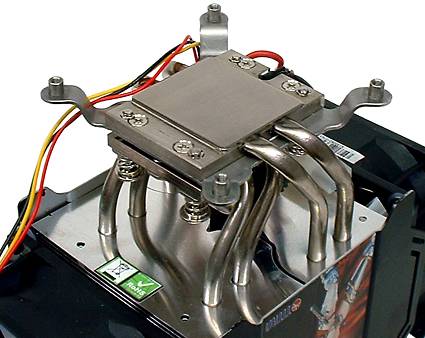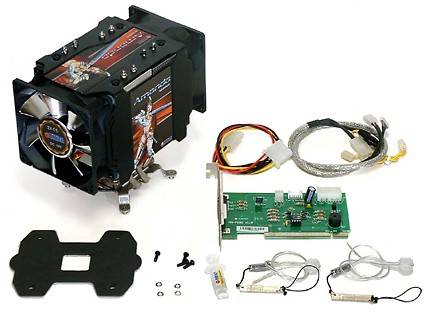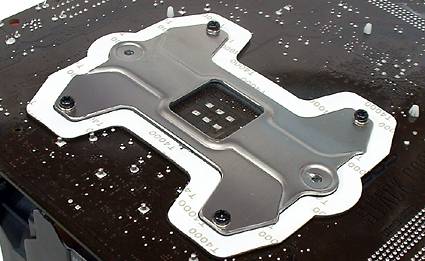Scythe Ninja Plus takes on Three TEC Heavyweights
Components And Installation
While other brands use a single intake fan that can be reconfigured as an exhaust fan, Titan populates both the intake and exhaust locations with 92 mm units of its own choosing. Though a shroud around its sinks makes the inclusion of both intake and exhaust fans redundant, "stacking" fans reduces the pressure differential for decreased air resistance. This allows the fans to spin more freely, resulting in a slight increase in airflow.
The cooler's bottom features a smooth copper base plated in a soft silvery metal (tin?) to prevent oxidation. This particular cooler is designed specifically for LGA775 processors, with a different mounting bracket than found on competing brands.
Also seen from the bottom is the dual-sink design found in similar products, where the front sink cools the CPU directly, the TEC module cools the top side of the CPU block, and the rear sink cools the hot side of the TEC module. This design allows the TEC to operate only when the CPU reaches a threshold temperature, maintaining a temperature slightly above ambient to prevent condensation on the "cold" side. That is, at least until the TEC runs out of cooling power...
The Amanda TEC includes an installation guide, mounting bracket with screws and lockwashers, 4-pin power extension cable, interface cable, TEC controller card, thermal paste, and two quick-release support cables. The support cables can be attached to the top of the cooler and to portions of a tower case above the cooler, to relieve some of the weight that normally pulls downward against the motherboard. Though possibly a unique feature for Titan, it wasn't required for our test system, due to its horizontal configuration.
Another difference for Titan is the ease of installation of its product, using four screws from behind the motherboard. Though this does require that the motherboard be removed from the case, similar coolers had used spring-loaded nuts between the cooler bracket and sink assembly, which is a difficult-to-reach location on many motherboards.
Like similar products, the Titan sits too close to the tops of the memory modules on most motherboards, preventing the use of memory with oversized sinks. The best solution, naturally, is to use memory with "ordinary-sized" sinks.
Get Tom's Hardware's best news and in-depth reviews, straight to your inbox.
Current page: Components And Installation
Prev Page Introduction Next Page Old Favorites: Vigor Monsoon II Lite And Ultra ChillTec-
Ninja Plus is Junk. My origin cooler with dual 120mm fans, one front and one back create perfect air flow, temperature from 39C to 50C max. After installed Ninja Plus along dual fans remain place, temperature only 1C lower to as high as 51C. Blow my brain is, peoplee hype up gimmick without even test the dual 120mm fans in the box 1st then jump into conclusion Ninja excellency. Wasted my $ and time due to the unproven text result with flaws. I saying this because I even tested in socket 478 old pc, same thing with dual fans flow in case. In conclusion Ninja is ajavascript:%20void(0); piece of junk other than try sell hype..Reply





